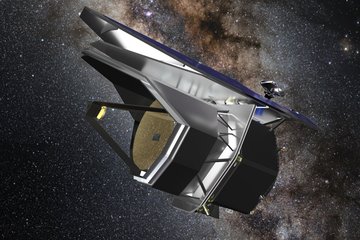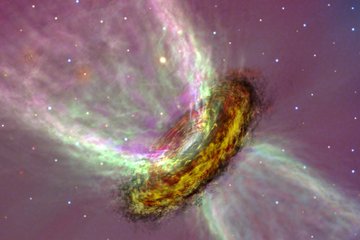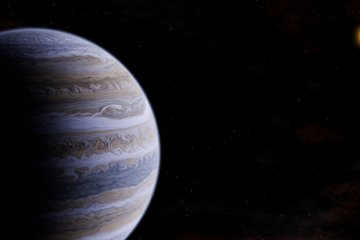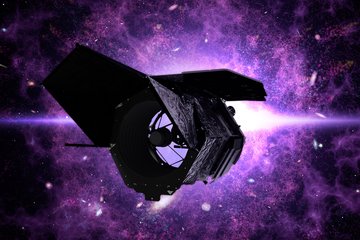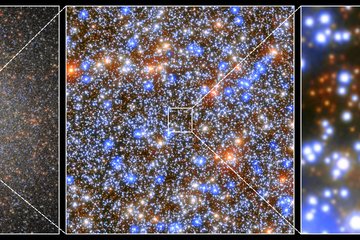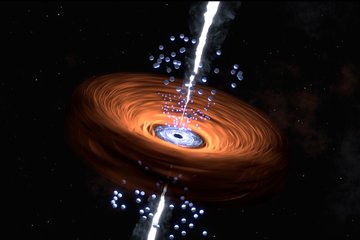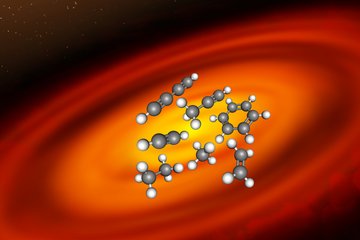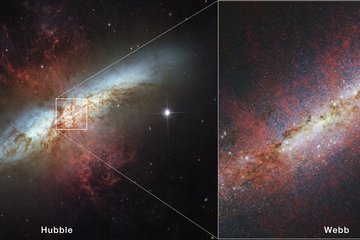A gigantic lane made of raw material for new stars
Astronomers discover a huge filament of atomic hydrogen, a possible precursor to star-forming clouds
A group of astronomers, led by researchers from the Max Planck Institute for Astronomy (MPIA), have identified one of the longest known structures in the Milky Way. It stretches some 3900 light-years and consists almost entirely of atomic hydrogen gas. This filament, called “Maggie”, could represent a link in the matter cycle of the stars. Analysing the measurements suggests that the atomic gas in this lane converges locally to form molecular hydrogen. When compressed in large clouds, this is the material from which stars eventually form.

Hydrogen is the most widespread substance in the Universe and the main ingredient in the formation of stars. Unfortunately, detecting individual clouds of hydrogen gas is a demanding task, which makes research into the early phases of star formation challenging. That is why the recent discovery of a surprisingly long structure, a filament, of atomic hydrogen gas by an international research group led by astronomers from the Max Planck Institute for Astronomy (MPIA) in Heidelberg is all the more exciting.

“The location of this filament has contributed to this success,” says Jonas Syed, a PhD student at MPIA and first author of the paper published today in the journal Astronomy & Astrophysics. “We don’t yet know exactly how it got there. But the filament extends about 1600 light-years below the Milky Way plane.” As a result, the radiation from the hydrogen, which is at a wavelength of 21 centimetres, stands out clearly against the background, making the filament visible.
“The observations also allowed us to determine the velocity of the hydrogen gas,” explains Henrik Beuther. He is a co-author of the study and heads the THOR (The HI/OH/Recombination line survey of the Milky Way) observing programme at MPIA, on which the data are based. “This allowed us to show that the velocities along the filament barely differ.” Therefore, the researchers conclude, it is indeed a coherent structure.
Its mean velocity is determined mainly by the rotation of the Milky Way disk. “With this information and a new method for analysing data, we managed to determine the size and distance of the filament,” says Sümeyye Suri. She is another co-author and former MPIA astronomer who now works at the University of Vienna. “It is about 3900 light-years long and 130 light-years wide.” At a distance of around 55,000 light-years, it is on the far side of the Milky Way. In contrast, the largest known clouds of molecular gas typically extend “only” about 800 light-years across.
Hydrogen occurs in the Universe in various states. Astronomers find it in the form of atoms and molecules, in which two atoms are joined together. Only molecular gas condenses to relatively compact clouds, which develop frosty regions where new stars finally emerge. But exactly how the transition from atomic to molecular hydrogen happens is still largely unknown. That makes the opportunity to study this extraordinarily long filament all the more exciting.

Co-author Juan D. Soler already found the first clue to this object a year ago. He named the filament “Maggie” after the longest river in his home country of Colombia, called the Río Magdalena. “Maggie was already recognizable in earlier evaluations of the data. But only the current study proves beyond doubt that it is a coherent structure,” explains Soler, who recently moved from MPIA to the Istituto Nazionale di Astrofisica (INAF) in Rome.
On closer inspection, the team noticed that the gas converges at some points along the filament. They conclude that the hydrogen gas accumulates at those locations and condenses into large clouds. The researchers also suspect that those are the environments where the atomic gas gradually changes into a molecular form.
In previously published data, they indeed found evidence of Maggie containing molecular hydrogen at a mass fraction of about 8 %. We may be looking at a region in the Milky Way where the immediate raw material for new stars is being produced. Hence, new stars could form here in the distant future. “However, many questions remain unanswered,” Syed points out. “Additional data, which we hope will give us more clues about the fraction of molecular gas, are already waiting to be analysed.”
Additional information
The team consists of Jonas Syed (Max Planck Institute for Astronomy, Heidelberg, Germany [MPIA]), Juan D. Soler (MPIA; Istituto di Astrofisica e Planetologia Spaziali, Istituto Nazionale di Astrofisica, Rome, Italy), Henrik Beuther (MPIA), Yuan Wang (MPIA), Sümeyye Suri (MPIA; Astrophysical Institute, University of Vienna, Austria), Jonathan D. Henshaw (MPIA), Manuel Riener (MPIA), Shmuel Bialy (Harvard Smithsonian Center, Cambridge, USA), Sara Rezaei Khoshbakht (MPIA; Chalmers tekniska högskola, Gothenburg, Sweden), Jeroen M. Stil (Department of Physics and Astronomy, The University of Calgary, Canada), Paul F. Goldsmith (Jet Propulsion Laboratory, California Institute of Technology, Pasadena, USA), Michael R. Rugel (Max Planck Institute for Radio Astronomy, Bonn, Germany), Simon C. O. Glover (Centre for Astronomy, Institute for Theoretical Astrophysics, University of Heidelberg, Germany [ZAH/ITA]), Ralf S. Klessen (ZAH/ITA; Interdisciplinary Centre for Scientific Computing, University of Heidelberg, Germany), Jürgen Kerp (Argelander Institute for Astronomy, University of Bonn, Germany), James S. Urquhart (Centre for Astrophysics and Planetary Science, University of Kent, UK), Jürgen Ott (National Radio Astronomy Observatory, Socorro, USA), Nirupam Roy (Department of Physics, Indian Institute of Science, Begaluru, India), Nicola Schneider (I. Phyikalisches Institut, University of Cologne, Germany), Rowan J. Smith (Jodrell Bank Centre for Astrophysics, University of Manchester, UK), Steven N. Longmore (Astrophysics Research Institute, Liverpool John Moores University, Liverpool, UK), Hendrik Linz (MPIA)
MN



